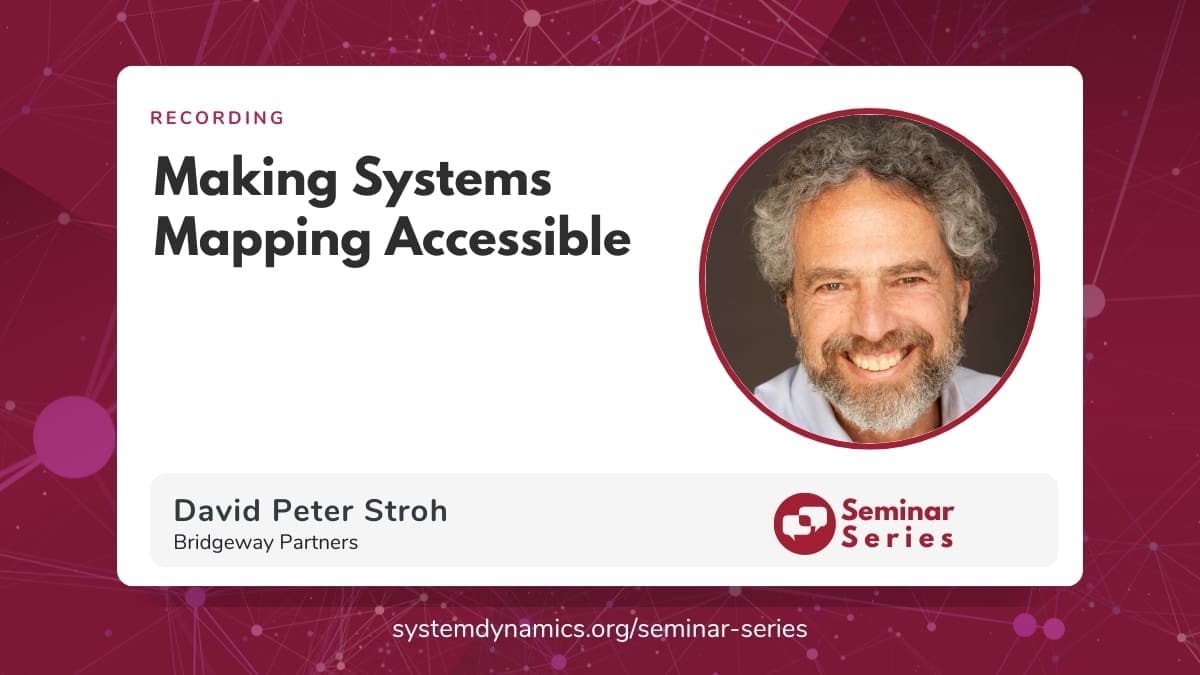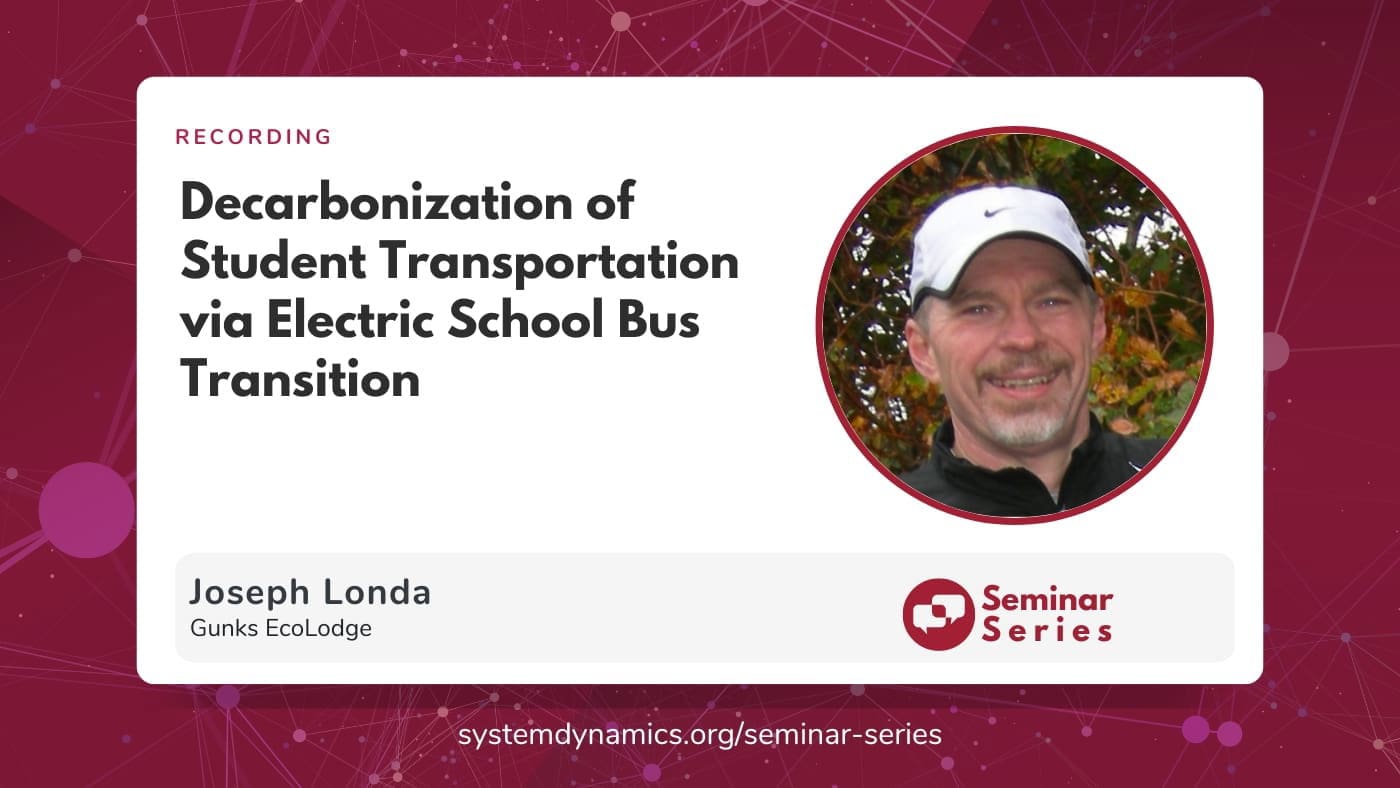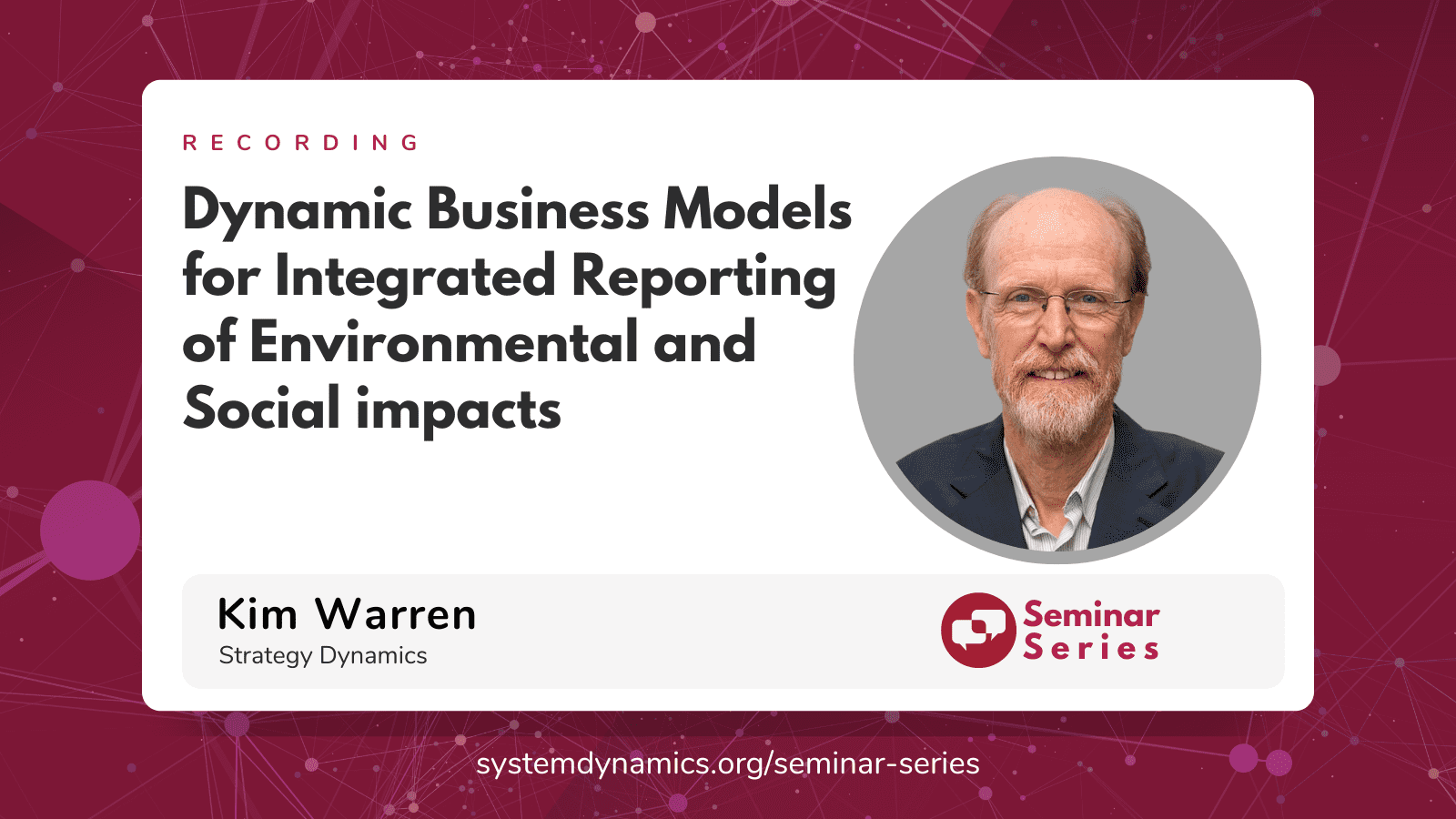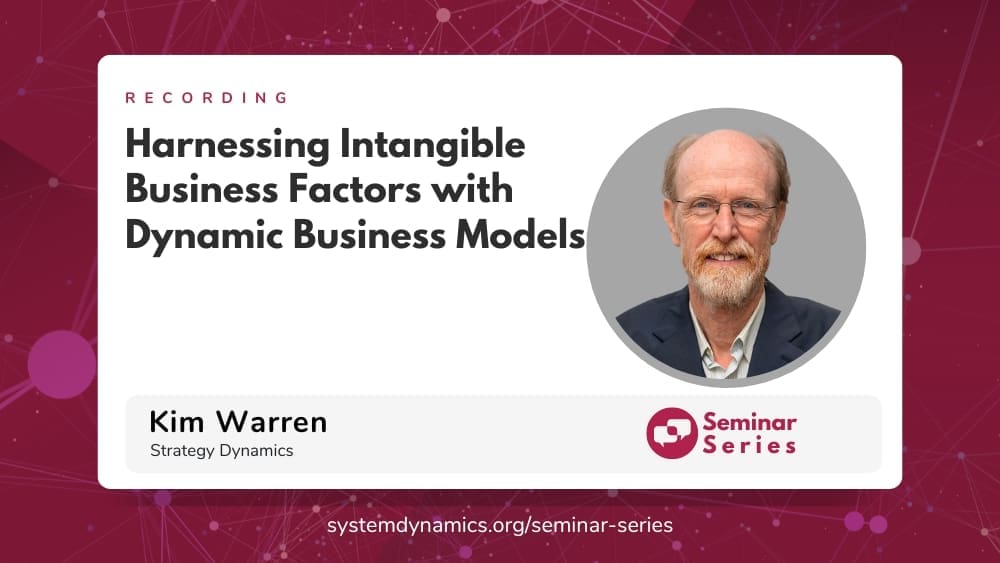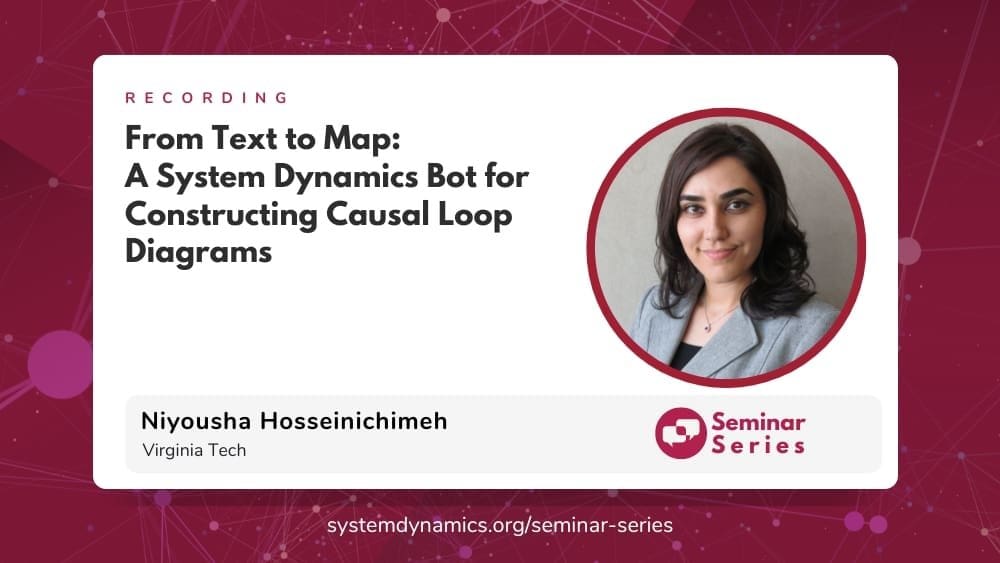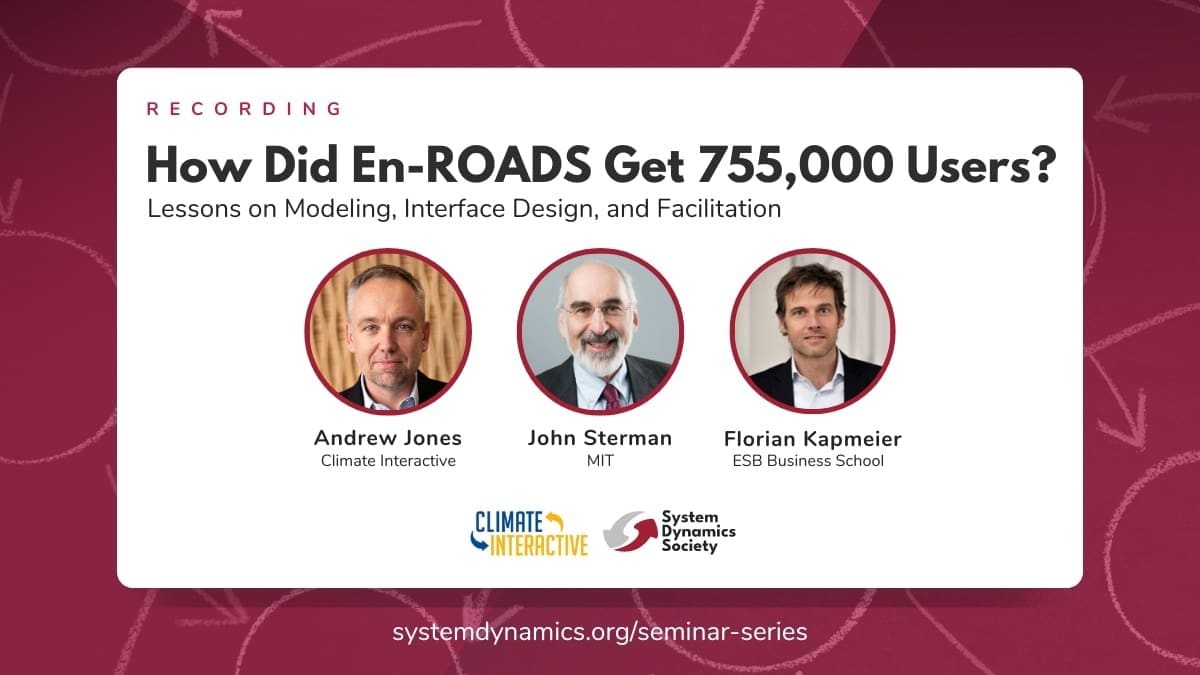Making Systems Mapping Accessible
The webinar “Making Systems Mapping Accessible” addressed six common misconceptions about systems mapping and offered alternative approaches for more effective model-building. David Peter Stroh, author of Systems Thinking for Social Change, led the discussion, focusing on the use of qualitative systems maps in organizational settings. The webinar included practical examples addressing intergenerational poverty, healthcare disparities, and global conservation efforts.
Overview and Context
David Peter Stroh began by explaining the significance of qualitative systems mapping. He emphasized that qualitative mapping helps stakeholders visualize their mental models and recognize blind spots, stating, “Systems thinking is mental models made explicit.” He outlined the goals of the webinar: clarifying the benefits of qualitative versus quantitative mapping, exposing myths, demonstrating practical applications, and offering tips for engaging stakeholders in model building.
Key Takeaways from the Webinar
-
Misconception: Systems Maps Must Capture Complete Systems Stroh argued that no system map can capture an entire system due to its complexity. Instead, effective qualitative maps should answer focusing questions beginning with “why.” He emphasized, “Effective qualitative maps answer focusing questions beginning with the word why.”
-
Misconception: The Value Lies in the Map Itself The process of map-making is as important as the map itself. Stroh highlighted that maps catalyze productive conversations about root causes, stimulate personal responsibility, and generate hypotheses about solutions. “Maps are effective because they catalyze productive conversations about root causes,” he noted.
-
Misconception: Objective Observers Make the Best Mappers Stroh suggested that the best mappers are part of the system they aim to change. “The greatest control anyone has over the behavior of a system is through their own intentions, thinking, and behavior,” he explained.
-
Misconception: Comprehensive Maps Are More Useful Effective maps simplify complexity and focus on what’s essential. Systems archetypes can help people recognize recurring patterns in complex systems. Stroh advised, “Use your map to tell a human story which distills why people’s well-intentioned efforts have been insufficient.”
-
Misconception: Useful Maps Take Months to Build Useful maps can be developed in weeks, days, or even hours. The critical factor is engaging key stakeholders early and ensuring their involvement throughout the process. “Useful maps can actually be developed in a matter of weeks or even hours,” Stroh asserted.
-
Misconception: Combining Problem and Solution Maps is Effective It’s essential to distinguish maps that explain problems from those that propose solutions. Awareness of the current system is the first step toward change. Stroh emphasized, “First help people fully appreciate why the problem has persisted.”
Practical Examples
Stroh shared examples of systems mapping applied to real-world issues:
-
Wealth Inequality: He illustrated the intergenerational cycle of poverty, explaining how unstable family environments lead to poor school performance, reduced earning power, and further poverty. “People caught in this vicious cycle are drowning, and collaboration among different support services is required to help them swim to shore,” he explained.
-
Healthcare Disparities: Stroh demonstrated how systemic racism in healthcare creates vicious cycles that perpetuate inequality. “The system of healthcare in the US works quite well if you’re white,” he noted, explaining the disparities faced by people of color.
-
Organizational Overload: He discussed how embracing too many priorities leads to overload, reduced collaboration, and ultimately, decreased effectiveness. “As priorities increase faster than the capacity to manage them, budget pressure and organizational overload ensue,” Stroh explained.
Tips for Engaging Stakeholders
Stroh offered several tips for engaging people in qualitative model building:
- Embed Systems Mapping in Change Management Processes: Integrate mapping with a conscious change management strategy.
- Establish a Focusing Question Early On: Focus the mapping process with a clear question.
- Gather Qualitative Data Through Interviews: Use interviews and supporting documentation to develop initial models.
- Develop Straw Models: Create preliminary models to guide discussions and refine them with stakeholder input.
- Engage Decision Makers: Involve leaders in reflecting and acting on the refined models.
Conclusion
The webinar concluded with a Q&A session, where Stroh emphasized the importance of seeing systems mapping as a catalyst for change. He encouraged participants to use qualitative maps to stimulate reflection and personal responsibility. For those interested in further resources, he recommended his book Systems Thinking for Social Change and provided additional references for deeper exploration.
Watch the recording below
About the Speaker
David Peter Stroh is a founding partner of Bridgeway Partners, a consulting firm that partners with mission-centered organizational leaders committed to advancing social and environmental transformation. He is internationally recognized for his work in enabling leaders to apply systems thinking to achieve breakthroughs around chronic, complex problems and to develop strategies which improve system-wide performance over time. David is also the author of the best-selling book Systems Thinking for Social Change: A Practical Guide for Solving Complex Problems, Avoiding Unintended Consequences, and Achieving Lasting Results.
Recent Posts
Society Governance Updates
New System Dynamics Society leadership
Call for Presenters: Seminar Series
Share your insights in the System Dynamics Society Seminar Series. Submit your proposal and join a global community of experts
Honoring Excellence: A Glimpse into the Awards of the International System Dynamics Conference
Dive into the prestigious awards and honorable mentions of the International System Dynamics Conference, celebrating trailblazers and emerging talents in the field
Upcoming Events

2024 International System Dynamics Conference
The International System Dynamics Conference is coming to Bergen! Save the date: August 4-8, 2024. We hope to see you there! #ISDC2024
Recent Business cases
System Dynamics Helps Evaluate Anticipatory Action on Cholera Outbreaks
Humanitarian agencies encourage anticipatory action in disaster response to cholera outbreaks in the Democratic Republic of Congo.
Management Design for Planted Forests in Japan Using System Dynamics
Hanno City in Saitama Prefecture used a system dynamics model to enable detailed analysis of labor requirements and changes in forest conditions.
Solving Bottlenecks in Dairy Production Facilities with System Dynamics
FriedslandCampina employed system dynamics to strategically enhance production efficiency in the midst of factory merging.
Join us
Decarbonization of Student Transportation via Electric School Bus Transition
The webinar on “Decarbonization of Student Transportation via Electric School Bus Transition” offered a deep dive into the complexities and potential solutions surrounding the transition to electric school buses. The session, led by Joe Londa, Environmental SIG Leader for the System Dynamics Society, featured detailed discussions on the systemic challenges and opportunities in adopting electric school buses in New York State.
Overview and Context
Joe Londa began by providing context to the New York State mandate requiring all school districts to transition to emission-free transportation by 2035. He highlighted the enormity of the task, noting that New York has 731 school districts operating approximately 50,000 gas and diesel buses. Joe outlined the primary areas of concern: battery range, cost, and whether to outsource transportation services. He remarked, “The transition to emission-free transportation is mandated, but the pathway is fraught with challenges, particularly around battery range and costs.”
One of the innovative approaches discussed was involving high school students in the project to develop a transition model. As Joe explained, “Students are key stakeholders in transportation, and involving them hands-on in developing analytical models gives them new skills and a sense of ownership.” Ten students from five districts participated in creating a Google Sheets-based model to simulate various transition scenarios.
Key Takeaways from the Webinar
-
Battery Range and Charging Infrastructure: The transition to electric school buses brings significant anxiety regarding battery range. Joe emphasized the critical nature of this concern: “Stranding students on the road is not an option.” The model developed included an analysis of route lengths and battery consumption to address these concerns.
-
Cost Considerations: Electric school buses currently cost twice as much as their diesel counterparts. Joe noted, “Early adopters will pay the highest prices, but they will also reduce greenhouse gas emissions sooner.” The model incorporated cost forecast scenarios to help districts plan financially.
-
Optimization of Bus Routes: The model also explored optimizing bus routes and sizes to ensure efficient use of electric buses. This analysis is crucial for districts with varying needs based on urban, suburban, and rural settings.
-
Challenges in Data Collection: Despite efforts, obtaining detailed data from school districts proved difficult. Joe shared his frustrations: “Superintendents and transportation directors were not very responsive to students’ data requests, leading to some frustration.” This highlighted a significant barrier in collaborative efforts.
This seminar underscores the importance of collaborative efforts in addressing local challenges for global problems like climate change, with a particular focus on sustainable transportation solutions.
Watch the recording below
About the Speaker
Joseph Londa, who after a distinguished 40-year career in technology at IBM and HCL Software, now runs the Gunks EcoLodge, a Net Zero Energy, fossil fuel-free retreat in the state of New York. Beyond his role as an innkeeper, Joseph is deeply committed to environmental sustainability, volunteering in his community to reduce greenhouse gas emissions and leading the Environmental SIG of the System Dynamics Society.
Recent Posts
Society Governance Updates
New System Dynamics Society leadership
Call for Presenters: Seminar Series
Share your insights in the System Dynamics Society Seminar Series. Submit your proposal and join a global community of experts
Honoring Excellence: A Glimpse into the Awards of the International System Dynamics Conference
Dive into the prestigious awards and honorable mentions of the International System Dynamics Conference, celebrating trailblazers and emerging talents in the field
Upcoming Events

2024 International System Dynamics Conference
The International System Dynamics Conference is coming to Bergen! Save the date: August 4-8, 2024. We hope to see you there! #ISDC2024
Recent Business cases
System Dynamics Helps Evaluate Anticipatory Action on Cholera Outbreaks
Humanitarian agencies encourage anticipatory action in disaster response to cholera outbreaks in the Democratic Republic of Congo.
Management Design for Planted Forests in Japan Using System Dynamics
Hanno City in Saitama Prefecture used a system dynamics model to enable detailed analysis of labor requirements and changes in forest conditions.
Solving Bottlenecks in Dairy Production Facilities with System Dynamics
FriedslandCampina employed system dynamics to strategically enhance production efficiency in the midst of factory merging.
Join us
Dynamic Business Models for Integrated Reporting of Environmental and Social Impacts
In the session “Dynamic Business Models for Integrated Reporting of Environmental and Social Impacts,” part of the System Dynamics for Business Innovation special series led by Kim Warren, the discussion focused on how Dynamic Business mMdels (DBMs) can be utilized for integrated reporting of environmental and social impacts. Here are the key takeaways from the session:
Understanding Integrated Reporting: Integrated reporting involves a comprehensive approach to corporate reporting that includes financial, environmental, and social impacts. Warren explained, “Integrated reporting is essential for enhancing accountability, stewardship, and trust while providing a transparent flow of information in business.”
The Six Capitals Model: Participants were introduced to the Six Capitals Model, which includes Financial, Manufactured, Intellectual, Human, Social and Relationship, and Natural Capital. Warren stated, “The Six Capitals Model helps businesses understand and report their impacts on various forms of capital.”
Specifying and Quantifying Impacts: Methods to specify, quantify, and simulate environmental and social impacts within DBMs were discussed. Warren emphasized, “Quantifying these impacts allows for better strategic decisions and a clearer understanding of a business’s value creation over the short, medium, and long term.”
Leveraging Dynamic Business Models: Strategies to leverage DBMs for integrated reporting were outlined. “Dynamic business models provide a robust framework for assessing and managing the interactions between a business and its social and environmental context,” Warren noted.
Warren classified the capitals into three main categories:
- Financial and Manufactured Capital: These include tangible assets like cash, equipment, and infrastructure.
- Intellectual and Human Capital: These encompass intangible assets like skills, patents, and employee motivation.
- Social, Relationship, and Natural Capital: These cover relationships within communities, environmental resources, and social impacts.
The Importance of Integrated Thinking: Integrated thinking is crucial for effective reporting. Warren illustrated, “Integrated thinking involves understanding the interconnectedness of different types of capital and how business activities affect them.”
Case Study: A real case study of a midsize manufacturing company in Turkey was presented. The company produces plastic packaging for food products and is a major employer in its local community. The business model illustrated how incorporating social and environmental considerations led to improved performance.
Environmental and Social Impact Assessment: The case study showed how the company assessed its impact on various capitals:
- Financial and Manufactured: Focused on sales, production capacity, and operational efficiency.
- Human Capital: Addressed staff satisfaction and productivity through reduced working hours and bonus schemes.
- Social and Relationship: Enhanced community cohesion and company reputation by contributing to local prosperity and employee well-being.
- Natural Capital: Implemented measures to reduce energy use and carbon emissions by investing in more efficient processes and increasing the use of recycled materials.
The case study demonstrated that by integrating social and environmental strategies, the company not only improved its sustainability performance but also achieved higher profitability. “Investing in social and environmental initiatives led to increased staff satisfaction and productivity, reduced environmental impact, and ultimately higher financial returns,” Warren concluded.
Watch the full webinar recording for in-depth insights into developing dynamic business models for integrated reporting of environmental and social impacts. The recording showcases the potential of these models to enhance business strategy and operations, ensuring a more sustainable and responsible approach to business management.
Courses
Dynamic Business Modelling Core Course
Watch the recording below
About the Speaker
Kim Warren is an experienced strategy professional, teacher, and publisher of online courses and teaching resources on business modeling – fast becoming a mainstream capability for executives, consultants, and business students. He was awarded the Jay Wright Forrester Award by the International System Dynamics Society in 2005 and was the Society’s President in 2013.
Recent Posts
Society Governance Updates
New System Dynamics Society leadership
Call for Presenters: Seminar Series
Share your insights in the System Dynamics Society Seminar Series. Submit your proposal and join a global community of experts
Honoring Excellence: A Glimpse into the Awards of the International System Dynamics Conference
Dive into the prestigious awards and honorable mentions of the International System Dynamics Conference, celebrating trailblazers and emerging talents in the field
Upcoming Events

2024 International System Dynamics Conference
The International System Dynamics Conference is coming to Bergen! Save the date: August 4-8, 2024. We hope to see you there! #ISDC2024
Recent Business cases
System Dynamics Helps Evaluate Anticipatory Action on Cholera Outbreaks
Humanitarian agencies encourage anticipatory action in disaster response to cholera outbreaks in the Democratic Republic of Congo.
Management Design for Planted Forests in Japan Using System Dynamics
Hanno City in Saitama Prefecture used a system dynamics model to enable detailed analysis of labor requirements and changes in forest conditions.
Solving Bottlenecks in Dairy Production Facilities with System Dynamics
FriedslandCampina employed system dynamics to strategically enhance production efficiency in the midst of factory merging.
Join us
Harnessing Intangible Business Factors with Dynamic Business Models
In the session “Harnessing Intangible Business Factors with Dynamic Business Models,” part of the “System Dynamics for Business Innovation” series led by Kim Warren, the conversation centered on how intangible assets like reputation, skills, data, and quality affect—and are affected by—the development of a business system and its performance. Here are the key takeaways from the session:
- Understanding Intangible Factors: Intangible factors such as reputation, skills, and data play crucial roles in business systems. Warren stated, “Intangible factors are not just qualitative; they can and should be quantified.”
- Specifying and Quantifying Intangibles: Participants learned methods to specify, quantify, and simulate intangible factors within dynamic business models (DBMs). Warren shared, “Dynamic business models can reliably incorporate intangible elements, allowing for better strategic decisions.”
- Leveraging Intangible Assets: Strategies to harness intangible assets for business growth and sustainability were discussed. “Understanding and managing intangibles can lead to significant improvements in business performance,” Warren noted.
Warren classified intangible factors into three main categories: State of Mind (e.g., reputation, motivation), Information-based (e.g., data, procedures), and Quality-related (e.g., product quality). Each category plays a crucial role in the overall dynamics of business systems, impacting everything from customer loyalty to operational efficiency.
State of mind intangibles influence behaviors such as customer loyalty and staff productivity. As Warren illustrated, “State of mind drives behavior, which in turn impacts business performance.” Information-based intangibles, including customer data and procedural knowledge, are vital for improving operational efficiency and customer satisfaction. Accurate and comprehensive information helps businesses operate smoothly and meet customer needs effectively. Additionally, improving product or service quality over time enhances reputation and fosters customer loyalty. Conversely, negative qualities, like software bugs, need to be minimized to avoid damaging the business’s reputation and customer trust.
Watch the full webinar recording below. It provides in-depth insights into the development, functionality, and applications of leveraging intangible business factors with dynamic business models, showcasing its potential to improve business strategy and operations.
Courses
How to Build Intangibles into Your Dynamic Business Models
Modelling Intangible Factors + Modeling Essentials
Watch the recording below
About the Speaker
Kim Warren is an experienced strategy professional, teacher, and publisher of online courses and teaching resources on business modeling – fast becoming a mainstream capability for executives, consultants, and business students. He was awarded the Jay Wright Forrester Award by the International System Dynamics Society in 2005 and was the Society’s President in 2013.
Recent Posts
Society Governance Updates
New System Dynamics Society leadership
Call for Presenters: Seminar Series
Share your insights in the System Dynamics Society Seminar Series. Submit your proposal and join a global community of experts
Honoring Excellence: A Glimpse into the Awards of the International System Dynamics Conference
Dive into the prestigious awards and honorable mentions of the International System Dynamics Conference, celebrating trailblazers and emerging talents in the field
Upcoming Events

2024 International System Dynamics Conference
The International System Dynamics Conference is coming to Bergen! Save the date: August 4-8, 2024. We hope to see you there! #ISDC2024
Recent Business cases
System Dynamics Helps Evaluate Anticipatory Action on Cholera Outbreaks
Humanitarian agencies encourage anticipatory action in disaster response to cholera outbreaks in the Democratic Republic of Congo.
Management Design for Planted Forests in Japan Using System Dynamics
Hanno City in Saitama Prefecture used a system dynamics model to enable detailed analysis of labor requirements and changes in forest conditions.
Solving Bottlenecks in Dairy Production Facilities with System Dynamics
FriedslandCampina employed system dynamics to strategically enhance production efficiency in the midst of factory merging.
Join us
From Text to Map: A System Dynamics Bot for Constructing Causal Loop Diagrams
We had an insightful webinar titled “From Text to Map: A System Dynamics Bot for Constructing Causal Loop Diagrams.” The session, led by Niyousha Hosseinichimeh, explored the capabilities and challenges of a novel tool designed to automate the creation of causal loop diagrams (CLDs) from textual data. Here are the key takeaways from the presentation:
Overview of the System Dynamics Bot
The System Dynamics Bot aims to automate the process of constructing CLDs from text, leveraging large language models and generative artificial intelligence. Niyousha Hosseinichimeh emphasized the tool’s potential by stating, “The System Dynamics Bot can streamline the modeling process, making it less labor-intensive and more efficient.”
- Capabilities of Large Language Models: The bot uses deep learning techniques to process and interpret text, identifying causal relationships and constructing CLDs. This demonstrates the potential of large language models in system dynamics and model building.
- Effectiveness and Practical Examples: Practical examples during the webinar showcased the bot’s ability to convert textual data into causal loop diagrams, effectively capturing significant feedback loops and causal links. Hosseinichimeh noted, “This tool offers a novel way to enhance our understanding of complex systems by automating the creation of causal loop diagrams.”
Evaluation of the Bot’s Performance
Two data sets were used for evaluation:
- Data Set One: Included 20 CLDs from system dynamics literature, capturing 60% of causal links and 66% of feedback loops on average.
- Data Set Two: Included responses from 30 individuals, with the bot capturing 56% of causal relationships and 83% of feedback loops.
Applications and Future Directions
The bot can significantly save time and effort in developing CLDs, assisting both novice modelers and experienced practitioners. Potential applications include:
- Educational Tools: Enhancing the learning experience for system dynamics students.
- Group Model Building: Supporting the creation of causal loop diagrams during group sessions.
- Comparative Studies: Comparing human-generated and AI-generated models to improve accuracy and insights.
- Literature Review-Based CLDs: Synthesizing information from various fields to create comprehensive diagrams.
- Mapping Mental Models: Analyzing how different individuals perceive complex issues.
Hosseinichimeh highlighted, “This program can be used to generate literature review-based causal loop diagrams and aid in group model building sessions,” showcasing its versatility and practical benefits.
Watch the full webinar recording below. It provides in-depth insights into the development, functionality, and applications of the System Dynamics Bot, showcasing its potential to revolutionize how we construct and interpret causal loop diagrams.
Watch the recording below
Whoops, this recording is available for members and ticket purchasers only. Please login to verify. If you’re not a member, purchase a membership here. You can also buy a ticket to watch the recording here.
PRESENTERS
Niyousha Hosseinichimeh has a PhD and a master’s degree in public administration and policy from State University of New York at Albany, and a bachelor’s degree in mechanical engineering from Sharif University, Iran. She is currently an assistant professor at the Department of Industrial and Systems Engineering at Virginia Tech. Her research focuses on developing and applying methods to improve health and healthcare systems. She uses simulation models to help stakeholders improve their understanding and decision making in complex dynamic systems. She has applied system dynamics approach to diverse health issues including infant mortality, mental health, and alcohol impaired driving among teens. Her methodological contributions include expanding calibration methods for dynamic models and developing techniques for system dynamics group model building. Her research has been funded by the National Institute of Health, National Science Foundation, Agency for Healthcare Research and Quality, Ohio State Department of Health, and Burroughs Wellcome Fund.
Recent Posts
Society Governance Updates
New System Dynamics Society leadership
Call for Presenters: Seminar Series
Share your insights in the System Dynamics Society Seminar Series. Submit your proposal and join a global community of experts
Honoring Excellence: A Glimpse into the Awards of the International System Dynamics Conference
Dive into the prestigious awards and honorable mentions of the International System Dynamics Conference, celebrating trailblazers and emerging talents in the field
Upcoming Events

2024 International System Dynamics Conference
The International System Dynamics Conference is coming to Bergen! Save the date: August 4-8, 2024. We hope to see you there! #ISDC2024
Recent Business cases
System Dynamics Helps Evaluate Anticipatory Action on Cholera Outbreaks
Humanitarian agencies encourage anticipatory action in disaster response to cholera outbreaks in the Democratic Republic of Congo.
Management Design for Planted Forests in Japan Using System Dynamics
Hanno City in Saitama Prefecture used a system dynamics model to enable detailed analysis of labor requirements and changes in forest conditions.
Solving Bottlenecks in Dairy Production Facilities with System Dynamics
FriedslandCampina employed system dynamics to strategically enhance production efficiency in the midst of factory merging.
Join us
How Did En-ROADS Get 755,000 users? Lessons on Modeling, Interface Design, and Facilitation
How Did En-ROADS Get 755,000 users? Lessons on Modeling, Interface Design, and Facilitation
Achieving widespread engagement is a significant challenge with a System Dynamics model. Yet, En-ROADS, the climate solutions simulator co-developed by Climate Interactive and MIT Sloan, has captivated hundreds of thousands of users globally. In this webinar led by Andrew Jones, John Sterman, and Florian Kapmeier, the team shared how their commitment to System Dynamics modeling principles, innovative interface design, and thoughtful facilitation created a global movement. The lessons learned are relevant for all System Dynamics modelers seeking to make a greater impact in their fields.
1. Modeling: Build Trust and Ensure Accuracy
“You have to have a rigorous, evidence-based model that is fully documented and tested every which way.” John Sterman
En-ROADS’ impact is built on a robust modeling foundation that adheres to rigorous standards of transparency and continuous testing. John Sterman underscores the importance of rigorous validation: “You have to have a rigorous, evidence-based model that is fully documented and tested every which way,” he states, highlighting the necessity for clear, accessible documentation that allows users to understand and trust the model’s operations.
The En-ROADS team enhances model reliability by calibrating past model behavior against historical data (by, e.g. Lazard, the IEA, etc.) and comparing future model behavior against the behavior of climate models used by the Intergovernmental Panel on Climate Change (IPCC), identifying discrepancies not only to prove correctness, but also to pinpoint areas needing improvement. Andrew Jones elaborates on this process: “We compare the model against historical data to understand where the discrepancies are and how we can improve. It’s not about proving the model’s correctness but about identifying areas for growth and improvement.”
For System Dynamics modelers looking to build confidence in the model, these practices are essential. Providing full transparency through comprehensive documentation and continuously validating models against industry benchmarks are crucial steps in establishing credibility. By adhering to these principles, modelers can ensure their models are technically robust and able to support decision-making.
2. Interface Design: Guide Users to Key Insights
“We designed the interface to lead a user to discover our modelers’ top insights without support.” Andrew Jones
En-ROADS’ interface is designed to ensure users reach key insights intuitively. Andrew emphasized the goal: “We designed the interface to lead a user to discover our modelers’ top insights without support.” The interface offers both a beginner mode for quick understanding and an advanced mode for users with more technical skills, providing detailed charts and additional assumptions. Dynamic visuals and animations transform static data into a narrative, making complex concepts accessible and engaging.
Within a few minutes exploring the En-ROADS interface, new users quickly grasp three critical insights:
- “It’s still possible” – to bend the emissions curve and reduce average temperature increase.
- “There’s no silver bullet”, highlighting that no single solution can solve the climate crisis.
- “Many solutions together”, emphasizing that combining multiple climate solutions is necessary to mitigate the climate crisis.
An interface designed around key insights helps users understand complexity. The ease of engaging with a new innovation—trialability—is crucial for initial adoption and fostering word of mouth. Yet, negative experiences can lead to adverse feedback, potentially stifling the adoption and diffusion of the model. Sterman emphasized: “if people try something and have a bad experience, they will generate unfavorable word of mouth that can squelch the adoption and diffusion of your model.”
John Sterman emphasizes the consequences of neglecting interface quality: “Suppose you have the world’s greatest model, but a terrible interface. Nobody learns anything, nothing will change, and you and everyone have wasted precious time and resources. That’s a failure mode.” But he warns, “The opposite, though, is far more dangerous: a great interface with an underlying model that lacks integrity and hasn’t been carefully tested means you’re helping people learn things that are wrong and possibly downright harmful far more effectively than ever before.”
By focusing on intuitive design and rigorous validation, En-ROADS ensures that the simulation is insightful and reliable for understanding possible climate solutions. This strategy serves as a reference for those aiming at making their models both informative and influential. As a System Dynamics Modeler, which 2-3 key takeaways would you like users to learn from your model?
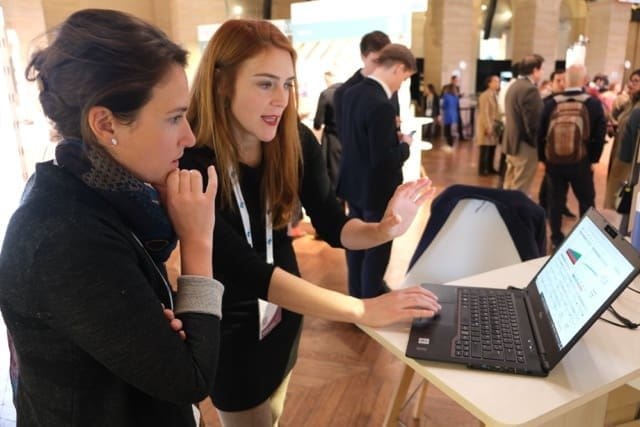
3. Facilitation: Create a Safe Space for Learning
“Make sure that you create a safe room where participants can share and challenge their mental models to allow them to engage deeply and learn together.” – Florian Kapmeier
Facilitation is critical to En-ROADS’ global impact. Through experiences like the interactive En-ROADS Climate Workshop and the roleplaying game Climate Action Simulation Game, Climate Interactive effectively conveys the insights of the model by fostering environments that encourage deep learning and reflection. Florian Kapmeier emphasized the importance of these settings: “Make sure that you create a safe room where participants can share and challenge their mental models to allow them to engage deeply and learn together.” This approach allows participants to openly test their assumptions and understand the underlying dynamics of climate change.
Florian, referred to Andrew’s Top 10 Tips to Engage People with a System Dynamics Model, highlighting one key aspect: By asking participants to mentally the likely impact of a climate solution on the temperature before running a scenario in En-ROADS, participants reveal their existing mental models and learn more effectively by comparing their understanding with model results. “Learning happens when the theory of thinking is laid out and people have to make a choice.”
The commitment to creating a secure and open space for dialogue is foundational to the success of the engagements with En-ROADS. This facilitation strategy enhances the participants’ ability to understand complex concepts, and encourages them to apply these insights in practical and impactful ways. By ensuring that each session serves as a safe space for exploration and challenge, Climate Interactive fosters an environment where transformative learning and genuine understanding can occur.
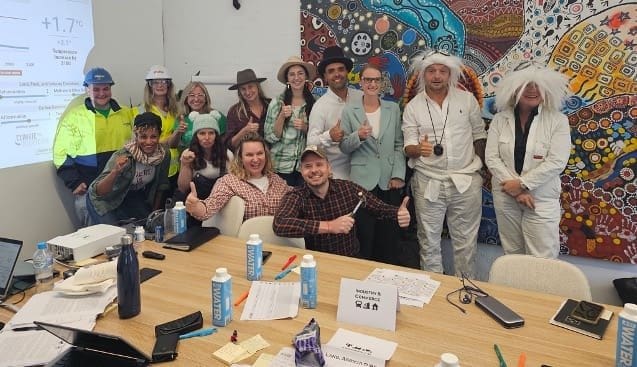
Climate Action Simulation for IKEA, Australia
Community & Policy Engagement
Community building has been fundamental to extend En-ROADS’ reach globally. Thousands have completed the Mastering En-ROADS training program, which empowers facilitators to engage diverse audiences. The En-ROADS Climate Ambassador program further nurtures hundreds of facilitators who provide En-ROADS Workshops and Climate Action Simulations worldwide, ensuring a unified network of like-minded advocates. This well-structured support system ensures that these facilitators are equipped to spread their knowledge effectively, fostering a collaborative and impactful community.
In addition to training and support, Climate Interactive’s team emphasized the importance of engaging with policy makers, adapting communication to meet where they are in terms of climate change understanding. Presenting complex model data in an accessible manner is crucial for meaningful engagement. This strategy ensures that decision-makers receive information and are equipped to act on it.
The Power of System Dynamics
“System Dynamics is the most powerful way to engage other people in ways to improve system performance.” – John Sterman
The success of En-ROADS hinges on a commitment to the core principles of System Dynamics, paired with innovative interface design and effective facilitation strategies. This approach has educated a global audience on climate solutions and empowered them to act. John Sterman, reflecting on the broader implications, asserts, “System dynamics is the most powerful way to engage other people in ways to improve system performance”, underscoring the potential of System Dynamics to facilitate meaningful discussions and drive change across various domains.
Sterman reminded the audience that the discipline’s strength lies in its ability to convey complexity in a way that decision-makers can understand and act upon: “System Dynamics modelers need to invite people into the conversation, to join the collective effort and improve system performance together.” This collaborative spirit is reflected in the global network of facilitators, policymakers, and climate advocates brought together by En-ROADS.
As System Dynamics modelers, the challenge is to not only build robust models but also to design engaging interfaces, facilitate participatory workshops, and nurture a community of like-minded advocates. By doing so, modelers can extend their influence beyond their field and create meaningful change in the world.
Watch the recording below
Recent Posts
Society Governance Updates
New System Dynamics Society leadership
Call for Presenters: Seminar Series
Share your insights in the System Dynamics Society Seminar Series. Submit your proposal and join a global community of experts
Honoring Excellence: A Glimpse into the Awards of the International System Dynamics Conference
Dive into the prestigious awards and honorable mentions of the International System Dynamics Conference, celebrating trailblazers and emerging talents in the field
Upcoming Events
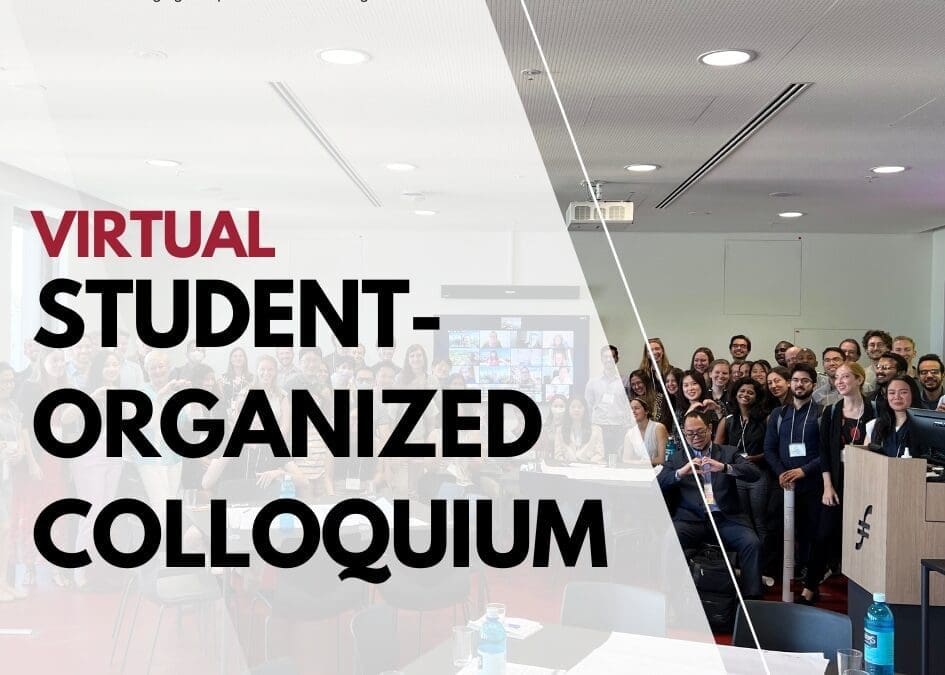
VIRTUAL | Student-Organized Colloquium 2024
Open to all! Bringing together students and practitioners from different industries to share ideas, and develop modeling skills
Recent Business cases
System Dynamics Helps Evaluate Anticipatory Action on Cholera Outbreaks
Humanitarian agencies encourage anticipatory action in disaster response to cholera outbreaks in the Democratic Republic of Congo.
Management Design for Planted Forests in Japan Using System Dynamics
Hanno City in Saitama Prefecture used a system dynamics model to enable detailed analysis of labor requirements and changes in forest conditions.
Solving Bottlenecks in Dairy Production Facilities with System Dynamics
FriedslandCampina employed system dynamics to strategically enhance production efficiency in the midst of factory merging.

